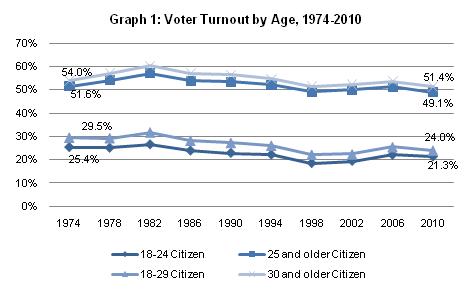2014 Midterms: Lessons from the 2010 Elections about Turnout among Registered Youth
With the 2014 midterm elections just over the horizon, conversations have begun about the potential influence of youth. CIRCLE has been studying this issue for some time. Youth participation is consistently lower in midterm elections than in presidential elections. Even when youth turnout in presidential elections has risen, midterm turnout has remained roughly the same.

Most young adults (18-24) who register to vote actually vote in presidential years; but in midterm years, many registered young adults do not vote. The pattern is somewhat different for college and non-college youth. In response to a question that we received, we ran the following table:
Note that the turnout of youth who registered to vote has been very high in recent presidential elections, but was not nearly as high in the 2010 midterm.
Why did many registered youth not vote in 2010? Young people in college were most likely to say that they didn’t vote in 2010 because they were “too busy” or faced “conflicting work” (34.7%) or were “out of town or away from home” (23.1%). In contrast, only 5.3% of non-college youth cited the latter reason for not voting. However, they were more likely to say that they were “not interested” (19.4%) or “forgot to vote” (12.3%).
In 2010, many college students who were in school in a different state from their primary residence lacked information on how to vote via absentee ballot, which is often a multi-step process. Providing information to college students on how to cast absentee ballots could also help youth already registered to vote. Our groundbreaking National Study of Learning, Voting, and Engagement is generating insights and data on how to engage college students.
The “other reasons” category is quite large, especially for non-college youth, 33% of whom chose it. Additional research would be required to learn more about their reasons. At least 30% of both students and non-college youth said they were “too busy” or had “conflicting work.” Increased outreach by campaigns and organizations could help motivate some of these young people to vote, as we’ve seen from previous research about the “power of the ask.”
Additional—and perhaps markedly different–efforts are required to reach young people who aren’t in college. They start with lower levels of knowledge and engagement; they are less likely to hold the government IDs required for voting in some states; and they are harder to contact because they are not concentrated on college campuses. Some effective nonpartisan groups do reach out to non-college youth, often using cultural organizing and social media. Non-college youth are most likely to benefit from favorable policies, including better k-12 civic education and more convenient voting. See the report of CIRCLE’s Commission on Youth Voting and Civic Knowledge for policy recommendations.
For more comparison of midterm and presidential elections, see a previous post in which we compared reasons youth who did not vote gave in 2008 compared to 2010.







